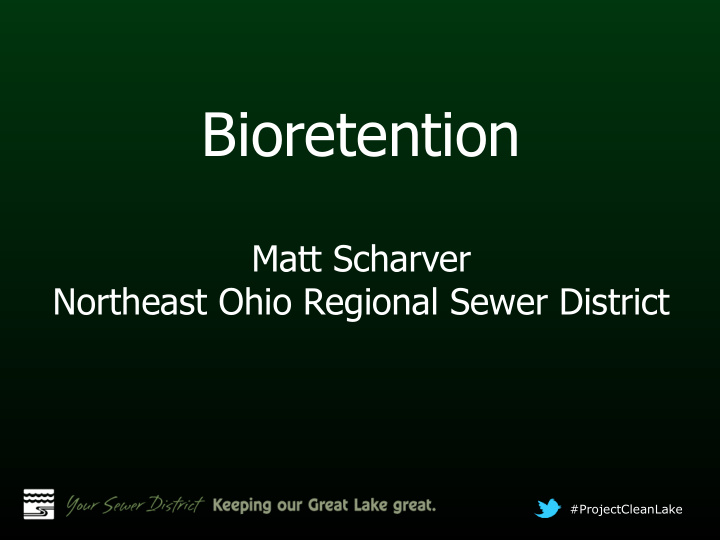



Bioretention Matt Scharver Northeast Ohio Regional Sewer District #ProjectCleanLake
Stormwater Management Training for MS4 Municipal Employees • Training Session Agenda – Pre-Training Survey – Presentation & Site Visit – Post-Training Survey • Today’s Selected SCM: Bioretention – Design features – Construction pitfalls – Operation & Maintenance activities #ProjectCleanLake
Stormwater Control Measure Bioretention/Bioswale Bioretention #ProjectCleanLake
Bioretention Concept Overflow to local sewer or environment #ProjectCleanLake
#ProjectCleanLake
#ProjectCleanLake
Bioretention/Rain Garden Design Key Design Considerations/Features • Hydrology • Inlets and Outlets • Materials • Vegetation #ProjectCleanLake
Bioretention / Rain Gardens • Uses soil media, mulch, and vegetation to reduce runoff and treat stormwater • Treatment occurs through: – Sediment settling – Microbial breakdown – Nutrient uptake by plants – Infiltration – Detention #ProjectCleanLake
Bioretention/Rain Garden Design Basics • Designed to treat the Water Quality Volume – Water Quality Volume = runoff from the first ¾ inch of rainfall – Drain down in a day’s time – May be constructed online or offline #ProjectCleanLake
Bioretenion/Rain Garden Inlets Distributes runoff into bioretention via: – Curb cuts – Trench Drain – Grass swales or berms #ProjectCleanLake
Bioretention/Rain Garden Pre-Treatment Reduce sediment loads – Hydrodynamic separators – Grass inlets – Forebays #ProjectCleanLake
Bioretention/Rain Garden Treatment System Clean Out Mulch Bio-soil Sand Pea-gravel #57 Gravel Underdrain Underdrain #ProjectCleanLake
Bioretention Ponding Depths Should be 12 inches between the top of the bed and the top of the overflow #ProjectCleanLake
Bioretention Concept Overflow to local sewer or environment #ProjectCleanLake
Bioretention/Rain Garden Mulch • Double shredded hardwood • 3” layer • Keeps weeds down #ProjectCleanLake
Bioretention/Rain Garden Soil Media • Loamy Sand 2-4 feet • By Volume – 75% Sand (AASHTO M-6 OR ASTM C-33) – 15% fines (Native soil) – 10% Organic Matter (Compost) • pH 5.2-8.0 • Phosphorus 15-60 mg/kg #ProjectCleanLake
Bioretention Filter Layer • Prevents the planting soil from moving into the stone • 3 inches of sand over 3 inches of pea gravel #78 • NO FILTER FABRIC #ProjectCleanLake
Bioretention Gravel Layer/Underdrains • May or may not be designed with underdrains • 10-12 inch gravel bed of #57 washed stone • Should be 3 inches of gravel above and below underdrain tile #ProjectCleanLake
Bioretention/Rain Garden Vegetation • Tolerate temporary inundation • Natives or cultivars depending on look and function • Can include trees and shrubs • Best to plant in deliberate patterns and plants of the same type together to better identify weeds from intended plantings #ProjectCleanLake
Bioretention/Rain Garden Construction • Pre-Construction Meeting • Timing • Excavation • Structural Components • Planting • Mulching #ProjectCleanLake
Bioretention/Rain Garden Construction - Timing Constructed AFTER the upstream drainage area is stabilized – Avoid sealing off the native soils – Avoid fines contamination of the bio-soil mix #ProjectCleanLake
Bioretention/Rain Garden Construction - Timing • Ideally construct during dry weather • Do not leave open for extended periods of time #ProjectCleanLake
Bioretention/Rain Garden Construction - Excavation Properly sized equipment – Work from the sides – Avoid bottom compaction – Excavate in steps #ProjectCleanLake
Bioretention/Rain Garden Construction - Excavation • Sides of cell vertical • Bottom of cells level • Use bucket teeth to scarify sides and bottom of cell #ProjectCleanLake
Bioretention/Rain Garden Construction - Excavation • Erosion and Sediment control critical • Keep practice “off - line” for as long as possible • Stabilize side-slopes ASAP • Protect bio-soils with sheeting or geo- textile #ProjectCleanLake
Bioretention/Rain Garden Structural Components Inlet/outlet elevations critical to function – Water needs to get into the practice – Water needs to pond in the practice – Outlets will be elevated – Underdrain may be elevated to encourage infiltration – Cleanouts should be provided #ProjectCleanLake
What’s wrong in the photo? #ProjectCleanLake
Bioretention/Rain Garden Maintenance Key points… • “Reading the practice” • Interpreting flow paths • Listing of major maintenance components #ProjectCleanLake
Bioretention/Rain Garden Maintenance Key points… • Shredded vs. pine bark mulch • Routine vs. non-routine maintenance • Vegetation maintenance #ProjectCleanLake
Bioretention/Rain Garden Maintenance Key points… • Standing water, vegetation health, sediment & erosion • Note sediment accumulations • Note smaller orifice & outfall sizes • Note shape of bioswale … problem? • Note underdrain & inlet configuration #ProjectCleanLake
Bioretention/Rain Garden Maintenance Final tips… • Refer to individual SCM project O&M Manual • Obtain copies of As-Built Plans • Maintain accurate map of feature’s designed & constructed drainage area #ProjectCleanLake
Field Site: place site image here #ProjectCleanLake
Questions? #ProjectCleanLake
Recommend
More recommend